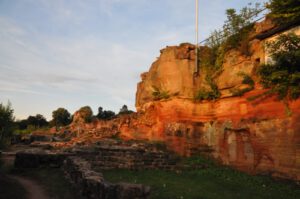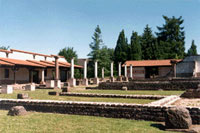
Homburg, Saar – Visitor Information
Homburg, the district and university town, has for decades been one of the destinations with a special appeal for those interested in art and cultural history.
Homburg has distinct tourist attractions in the form of the Schlossberg caves and the Roman Museum. But also the recreation area Jägersburg, the cultural park Homburg and the beautiful old town are worth a visit. With the ruins of the Vauban fortress Homburg, the castle Karlsberg, the monastery Wörschweiler as well as the Merburg and with the Gustavsburg, the culture park Homburg reminds of a changeful and sometimes proud past. The Hohenburg Castle, nowadays a ruin, was in the 12th Century the seat of the counts of Homburg. In 1330 the village received the town status (Stadtrecht) by Louis the Bavarian.

Ruins of the castle, palace and fortress of Homburg
In the 12th century, the Hohenburg was the seat of the Counts of Homburg, who received city rights for their town at the foot of the castle hill in 1330. After the death of the last Count of Homburg in 1449, the castle and the city fell to the Counts of Nassau-Saarbrücken. They expanded and fortified the castle with bastions. The French King Louis XIV commissioned Sébastien Prestre de Vauban, his famous master fortress builder, to transform it into a modern citadel.
The city itself received a city wall for the first time. The street layout of the old town dates from this period (1679-1697). The fortress had to be finally razed in 1697 and 1714.
Since 1981 the ruins on the castle hill have been uncovered and secured. Most of them date back to the fortress period.
The Römermuseum
The Roman Museum Homburg is one of the most famous destinations of the Saarpfalz district & surroundings. The museum stands on a part of the Roman quarter built from the time of Christ. a trading city of ancient Rome.
The Roman city was founded by Emperor Augustus. The city covered an area of about 25-30 hectares and had about 2,000 inhabitants. In today’s open-air museum you can see the excavations of Roman buildings and immerse yourself in the world of the Romans.
Homburger Strasse 38, Homburg-Schwarzenacker
The Römermuseum is open from April to October daily 09.00 – 17.00 except Sundays – 15.00 and in March daily 10.00 – 16.00, closed November thru February.
The Homburger Schlossberg Caves
Europe’s largest red sandstone caves are located below the ruins of the Homburg Fortress on the Schlossberg. Mysterious passages, created by man, lead visitors into imposing domed halls, which have a special charm due to the yellow and red coloring of the sandstone.
It is possible that the first passages dug into the castle hill served as a defense for the medieval Hohenburg Castle, which gave the town its name. After the death of the last Count of Homburg in 1449, the medieval castle complex and the town fell to the Counts of Nassau-Saarbrücken. In the Reunion period, the second half of the 17th century, the French King Louis XIV had his master fortress builder Sébastien Le Prêstre de Vauban develop the castle, which had been remodeled by the House of Nassau-Saarbrücken, and the town into a modern fortress. The fortifications were razed in 1697 and 1714.
Probably from the middle of the 17th century onwards, targeted underground mining of quartz sand began in the Schlossberg, which was probably used for glass production. After the French period, mining was carried out only temporarily to extract scouring sand for cleaning purposes as well as molding sand for the iron industry on a small scale.
After the caves fell into oblivion for some time, the present entrance was rediscovered in the 1930s. During the Second World War (especially 1944-1945) the people of Homburg found shelter from air raids in the caves.
Adjacent to the sandstone caves is an equally impressive bunker area, which was built in the early 1950s for the government of the Saar region at the time.
In addition to their eventful history, the Schlossberg caves also offer a unique insight into the period of formation of the red sandstone about 250 million years ago, shortly after the drastic change in time from the Permian to the Triassic. At that time, the current location was in the middle of a European-wide desert area.
The caves run through remnants of former sand dunes. In between lie red-colored alluvial sand deposits. In many cases, they contain striking wave patterns, fossilized ripple marks formed in the sandy substrate of shallow desert lakes. And in some places, footprints of small lizards that lived in this desert landscape can be discovered.
The Schlossberg caves have recently undergone extensive renovation with generous support from the Ministry of Economics. The newly created safety facilities made of concrete and steel not only provide the best possible protection in the caves, they are in turn worth seeing components of this unique visitor experience.
The caves can be visited by individual visitors over three floors. Waiting times are possible due to the safety briefing.
Group tours (in English, French or German) are also available. Groups please register in advance by phone at the caves. There is an additional fee of €10 per group tour. Please note that the caves have a constant temperature of 10 °C. Please make sure to wear suitable clothing.
From the old town, the caves can be reached via a stairway. Those arriving by car can park on the Schlossberg. Also from here, a staircase leads to the entrance of the Schlossberg caves.
The ruins of the Vauban fortress “Homburg la Forteresse” as well as the older castle and chateau complexes can be visited free of charge at any time. Visitors can download a gps-supported audio tour via the Lauschtour app and explore the fortifications individually. The Lauschtour is also translated into sign language and can be found in the app.
Opening hours: Summer: 9 am – 5 pm • Winter: 10 am – 4 pm
December & January closed.
Information and registration under:
06841 2064 or schlossberghoehlen@homburg.de
For more information, opening hours and admission prices, visit the website https://www.homburger-schlossberghoehlen.de


